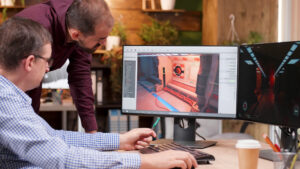Breaking Down The Elements Of Effective Graphic Design

In the world of graphic design, understanding the basics is essential for creating compelling and visually appealing designs. The use of balance, hierarchy, alignment, repetition, and contrast are the fundamental building blocks that every graphic designer should master.
Balance ensures that everything within the design feels harmonious and stable, while hierarchy guides the viewer’s attention and creates a sense of order. Alignment ensures that elements are properly positioned and connected, while repetition creates consistency and reinforces visual patterns. Lastly, contrast adds visual interest by emphasizing differences and creating a dynamic impact.
By understanding and applying these basic elements, designers can create designs that not only capture attention but also effectively communicate their message. Whether it’s a logo, a website, or a poster, mastering these foundational principles will greatly enhance the effectiveness and impact of your graphic designs. So let’s dive in and explore each of these elements in detail, to truly unlock the power of graphic design.
Negative Space
Negative space is a crucial concept in graphic design that refers to the empty area surrounding a positive shape or object. Also known as white space, negative space plays a significant role in defining the boundaries of a shape and bringing balance to a composition.
In design, the relationship between the shapes and the negative space they create is often referred to as the figure/ground relationship. The positive shape is the main subject of the design, while the negative space is the area surrounding it. This interplay is essential for creating visually interesting and dynamic designs.
A famous example that highlights the effective use of negative space is the World Wide Fund for Nature (WWF) logo. The logo features a simple black silhouette of a panda, which is the positive shape, against a negative space shaped like a panda’s face. This clever use of negative space not only creates a strong visual impact but also symbolizes the organization’s dedication to wildlife conservation.
By incorporating negative space strategically, designers can achieve a harmonious balance between positive and negative elements within a design. This balance can make the composition more visually appealing and create a sense of order and cohesion.
Basic Elements of Design
The basic elements of design are the building blocks that form the foundation of any visual piece. These elements, such as line, shape, form, color, texture, and space, are essential in art and design as they work together to construct visually appealing and meaningful compositions.
Line is the most fundamental element, as it can define shapes, create movement, and convey emotions. Shape, whether geometric or organic, adds structure and visual interest to a design. Form, on the other hand, adds depth and three-dimensionality to an artwork.
Color is another crucial element that can evoke emotions, convey messages, and create visual hierarchy. The choice of color palettes and color schemes can greatly impact the overall visual message. Texture adds a tactile quality to visual designs, making them more engaging and realistic.
Space, especially the use of positive and negative space, is key in creating visual balance and defining relationships between elements. The way elements are arranged in relation to the space around them can determine the overall impact and effectiveness of a design.
By understanding and effectively utilizing these basic elements of design, designers can create visually compelling and impactful pieces that effectively communicate their intended message. Each element plays a crucial role in establishing the overall visual message, and the combination and manipulation of these elements can greatly enhance the aesthetic appeal and effectiveness of a design.
Principles of Design
The principles of design play a vital role in organizing and prioritizing visual elements within a composition. These principles provide a framework for creating visually appealing and effective designs. Below are the 12 commonly mentioned principles of design:
- Balance: Achieving visual equilibrium by distributing elements evenly or creating intentional imbalances.
- Emphasis: Directing attention to a specific focal point or creating hierarchy within a composition.
- Contrast: Using differences in color, value, shape, size, or texture to create visual interest and highlight differences.
- Proportion: Establishing a pleasing relationship between the sizes of various elements within a design.
- Hierarchy: Arranging elements in order of importance to guide the viewer’s eye through the design.
- Repetition: Repeating visual elements such as color, shape, or pattern to create unity and consistency.
- Rhythm: Creating a sense of movement and flow by repeating visual elements or using consistent patterns.
- Pattern: Utilizing a recurring motif or design element to create visual interest and cohesion.
- White space: Strategically leaving areas of empty space to provide visual breathing room and enhance the overall composition.
- Movement: Creating a sense of motion or directing the viewer’s eye through the design.
- Variety: Introducing different elements or visual characteristics to add interest and avoid monotony.
- Unity: Ensuring that all elements within a design work together harmoniously to convey a cohesive and unified message.
By understanding and applying these principles of design, graphic designers can create visually compelling and well-organized compositions that effectively communicate with their audience.
Repetition, Pattern, and Rhythm for Visual Impact
Repetition, pattern, and rhythm are powerful design techniques that can create visual impact and enhance the overall appeal of graphic designs. These elements can be used to draw attention, provide consistency, and create a sense of harmony and movement within a design.
Repetition involves the deliberate use of recurring design elements, such as colors, shapes, or patterns, to create a sense of consistency and rhythm in a design. By repeating visual elements throughout a composition, designers can establish a unified and cohesive look. This technique not only creates a pleasing visual effect but also helps to guide the viewer’s eye and create a sense of harmony within the design.
Pattern, on the other hand, utilizes a recurring motif or design element to create visual interest and cohesion. By incorporating recognizable patterns or motifs, designers can create a sense of familiarity and engage the viewer. Patterns can be used to highlight important elements, add visual variety, or create a decorative effect.
Rhythm, in design, refers to creating a sense of movement and flow by repeating visual elements or using consistent patterns. By applying rhythm, designers can lead the viewer’s eye through the composition, creating a dynamic and engaging experience. Rhythm can be achieved through variations in size, spacing, or orientation of design elements.
To illustrate the effectiveness of these techniques, consider the examples of the Product Hunt homepage and the Valio Conference 2016 site. Both designs use repetition, pattern, and rhythm to create visual impact and design consistency. The Product Hunt homepage features repeated grids and icons, creating a sense of order and rhythm. The Valio Conference 2016 site incorporates a recurring circular motif, creating a cohesive and visually appealing design.
Symmetry to Create Order Out of Chaos
Symmetry in design involves creating balance and harmony by mirroring elements on either side of a central axis. This concept allows designers to bring order out of chaos by establishing a visually pleasing and organized composition. By using symmetry in design, the elements appear balanced and harmonious, creating a sense of stability and clarity.
There are three types of balance in design: symmetrical, asymmetrical, and radial. Symmetrical balance involves mirroring elements equally on both sides of a central axis, creating a sense of formal and deliberate composition. Asymmetrical balance, on the other hand, achieves balance by distributing visual weight unevenly, resulting in a more dynamic and informal composition. Radial balance involves organizing elements around a central focal point, creating a visually centered and harmonious design.
While all three types of balance have their merits, symmetrical design is often preferred due to its natural pleasing effect. It provides a sense of order, elegance, and completeness. Symmetry in design has a calming effect on the viewer and is often associated with beauty and perfection. It fosters a sense of trust and reliability, making it a popular choice for many brands and design projects.

Conclusion
In conclusion, effective graphic design is about creating visuals that are both aesthetically pleasing and communicative. It is about utilizing various elements such as color, typography, imagery, and layout to create a cohesive design that will resonate with users. It should also reflect the brand’s identity and core values in order to create a lasting impression. By understanding the fundamentals of graphic design, designers can craft designs that not only look appealing, but will also effectively communicate the desired message.





